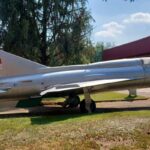The Mikoyan Gurevich MiG-21, nicknamed by NATO “Fishbed”, is a supersonic jet fighter with delta wing platform, designed by OKB 155 led by Artem Ivanovic Mikojan and Michail Iosifovic Gurevic at the end of 1953, when the Soviet aviation administration published a specific request for a completely new fighter, with maximum possible performances and taking into account all the lessons learnt in Korea. From the first project different proposals and prototypes were born, both MiG and Sukhoi with various wing configurations (arrow and delta) and engines. Even if some of these were produced in a small series, the most successful project was the MiG-21, produced from 1957 till 1985. Mainly used by Sovietskie Voenno-Vozdusnye Sily (VVS-Soviet Military Aviation), and by over 60 air forces of the Warsaw pact and Soviet-friendly, it was built in more than 11.000 units, gaining the record of mostly produced bi-sonic fighter in history. Even having been replaced in many Air Forces by more modern aircraft, the MiG-21, especially in the Chinese version originally built under license, is still operational in many Countries. The aircraft exhibited in Volandia is a MiG-21-PFM (fighter, engine-upgraded, improved) Fishbed E model. It was built in Soviet Union with serial number 94A6911 (from which the code 6911 that can be seen on various parts of the plane) and sold in April 1968 to the Polish Air Force, where it was used until 1996 by a Squadron based in the city of Poznan. The aircraft has the badge of 62° PLM on the fuselage and on the fin the crest of the city of Poznan. It was brought to Italy in 2000 by an entrepreneur who wished to use it as “gate guardian” in its factory, but never succeeded. Bought by Volandia in 2015 , it was accurately restored by ASAS, while Amici di Volandia took care of the painting and detailing.
MiG-21-PFM
Aircrafts

Technical Specifications
Name :
MiG-21
Family :
Fighter
Manufacturer :
Mikoyan-Gurevich
Nation :
USSR
Production Year :
1959
Dimensions
Length :
15.77 m
Span :
7.16 m
Height :
4.80 m
Wing Area :
23.00 m²
Weights
Empty :
4600 kg
Maximum Take-off :
8500 kg
Engines
1 Tumanskij R-11F-300 Turbojet
5750 kg Thrust
Performances
Maximum Speed :
2230 km/h
Range :
1670 km
Cealing :
17500 m
Armament
1 Gryazev-Shipunov GSh-23L 23 mm Cannon
4 Underwing Pilons for Laser Guided Bombs, air-to-air/ground Missiles
History



